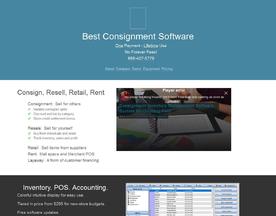How does consignment work ? Consignment involves selling items through a third party, who takes a cut when the items are sold.
Consignment is a business model that has been around for a long time, but many people are still unfamiliar with how it works. Essentially, consignment is a way for people to sell their goods without having to worry about the logistics of selling them. Instead of selling their items directly to a buyer, they give them to a consignment shop or online platform, which then sells the items on their behalf.

Understanding how does consignment work ? Consignment involves knowing the basic process of how it works. When someone consigns an item, they retain ownership of it until it is sold. The consignment shop or platform takes a percentage of the sale price as a commission, and the rest is paid back to the seller. This allows sellers to get rid of items they no longer want or need while still earning some money from them.
Understanding how does consignment work and the consignment process can vary depending on the specific shop or platform being used. Some places require sellers to drop off their items in person, while others allow for shipping. Certain consignment shops only accept certain types of items, while others have more flexibility. It is important for sellers to understand the specific rules and regulations of the consignment shop or platform they are using in order to ensure a successful transaction.
Key Takeaways
- Consignment is a business model where people sell their goods through a third-party shop or platform.
- Sellers retain ownership of their items until they are sold, and the consignment shop or platform takes a commission from the sale price.
- The consignment process can vary depending on the specific shop or platform being used, and it is important for sellers to understand the rules and regulations in order to have a successful transaction.
Understanding How Does Consignment Work ?
Definition and Basics
Consignment is a business arrangement where a consignor (the owner of the goods) entrusts their goods to a consignee (the seller) to sell on their behalf. The consignor retains ownership of the goods until they are sold, and the consignee receives a percentage of the sale price as commission for their services.
In the consignment model, the consignee takes on the risk of selling the goods and is responsible for marketing, displaying, and selling them. The consignor benefits from having their goods sold without having to invest in marketing or holding inventory.
Key Players: Consignor and Consignee
The consignor is the owner of the goods and is responsible for setting the price and conditions of the consignment agreement. They retain ownership of the goods until they are sold and receive payment from the consignee once the goods are sold.
The consignee is the seller who receives the goods from the consignor and is responsible for selling them. They receive a commission on the sale price as compensation for their services. The consignee takes on the risk of selling the goods and is responsible for marketing, displaying, and selling them.
Consignment Model Overview
The consignment model is a popular way for businesses to sell goods without having to invest in inventory or marketing. In this model, the consignor retains ownership of the goods until they are sold, and the consignee takes on the risk of selling them. The consignee receives a commission on the sale price as compensation for their services.
One of the advantages of consignment is that it allows businesses to offer a wider range of products without having to invest in inventory. It also allows consignors to sell their goods without having to invest in marketing or sales channels.
To learn more about how does consignment work and how it can benefit your business, check out this article from The Balance Small Business.
The Consignment Process
Consignment is a business model that allows a seller to offer their goods through a third party, who agrees to sell the goods for a commission. The process usually involves three stages: inventory management, consignment agreement, and sales management.
Stages of Consignment
The first stage is inventory management, which involves the seller providing a list of goods to the consignee. The consignee then inspects the goods and determines which items they are willing to accept. The consignee then takes possession of the goods and stores them until they are sold.
The second stage is the consignment agreement, which outlines the terms and conditions of the consignment. The agreement typically includes details such as the commission rate, the length of the consignment period, and the payment terms. Both parties sign the agreement, and the consignee is authorized to sell the goods on behalf of the seller.
The final stage is sales management, which involves the consignee marketing and selling the goods. The consignee is responsible for setting the price of the goods, displaying them in their store or online, and handling customer inquiries. Once the goods are sold, the consignee deducts their commission and remits the balance to the seller.
Inventory Management
Inventory management is a critical component of the consignment process. The consignee must ensure that the goods are stored safely and securely, and that they are easily accessible when needed. They must also keep accurate records of the goods, including their condition, location, and value.
To manage inventory effectively, consignees often use specialized software that allows them to track the goods in real-time. This software can provide valuable insights into the performance of the consignment, such as which items are selling well and which are not.
The Consignment Agreement
The consignment agreement is a legal document that outlines the terms and conditions of the consignment. It is important that both parties understand the terms of the agreement before signing it. The agreement should include details such as the commission rate, the length of the consignment period, and the payment terms.
The consignment agreement should also specify how the goods will be priced and marketed. It should include details such as the minimum and maximum price of the goods, and any restrictions on how they can be marketed.
To learn more about how does consignment work, check out this helpful guide from The Balance Small Business.
Types of Consignment Goods

Consignment stores accept a wide variety of goods from their consignors. Here are some of the most common types of consignment goods:
Clothing and Accessories
Clothing is one of the most popular items sold through consignment stores. Consignment shops often specialize in specific types of clothing, such as high-end designer items or vintage clothing. They may also accept accessories like jewelry, handbags, and shoes. Consignment stores typically only accept items that are in excellent condition and are current or timeless in style.
Furniture and Home Decor
Furniture and home decor items are also commonly sold through consignment shops. These items can include sofas, chairs, tables, lamps, and artwork. Consignment stores may also accept smaller items like home accessories, such as vases, picture frames, and decorative pillows. Consignment furniture is often high-quality and well-crafted, making it an attractive option for buyers looking for unique pieces for their home.
Art and Collectibles
Consignment stores are also a great place to find art and collectibles. These items can include paintings, sculptures, antique furniture, and other unique items. Consignment stores often have a wide variety of items to choose from, making it easy to find something that fits your personal style.
Toys and Baby Accessories
Consignment shops also accept toys and baby accessories. These items can include strollers, car seats, cribs, and toys for children of all ages. Consignment stores typically only accept items that are in excellent condition and are free from any safety hazards.
Overall, consignment stores offer a great way to buy and sell a wide variety of goods. By understanding the types of consignment goods that are commonly accepted, buyers and sellers can make the most of these unique shopping and selling opportunities.
For more information on how does consignment work, check out The Balance’s article on Consignment Shops.
Financial Aspects of Consignment
How does consignment work? Consignment is a business model where a consigner entrusts their goods to a consignee for sale. The consignee, in turn, agrees to sell the goods and pays the consigner a portion of the sale price. In this section, we will discuss the financial aspects of consignment.
Pricing Strategies
One of the most important aspects of how does consignment work is determining the sale price of the goods. The consignee and consigner must agree on a fair price that will attract buyers while still allowing for a profit. The consignee may use various pricing strategies, such as cost-plus pricing or market-based pricing, to determine the sale price.
Commission and Profit Sharing
The consignee receives a commission on the sale of the goods, which is a percentage of the sale price. The commission may vary depending on the type of goods and the agreement between the consignee and consigner. Profit sharing is another option, where the consigner and consignee agree to split the profit from the sale of the goods.
Cash Flow Considerations
Consignment can provide cash flow benefits to both the consigner and consignee. The consigner can receive payment for their goods without having to sell them outright, while the consignee can generate revenue without having to purchase inventory upfront. However, it is important to consider the potential risks and costs associated with consignment, such as storage and marketing expenses.
Overall, how does consignment work? It can be a beneficial business model for both parties involved, as long as the financial aspects are carefully considered and agreed upon. For more information on how does consignment work, check out this helpful resource from The Balance Small Business.
Consignment in Retail and E-commerce

Consignment is a popular business model in the retail industry, particularly in the sale of second-hand goods. It involves a consignor (the original owner of the item) entrusting an item to a consignee (the seller) for sale. The consignee then takes a percentage of the sale price as their commission and pays the remaining amount to the consignor.
Brick-and-Mortar Consignment Stores
Brick-and-mortar consignment stores are physical retail locations that specialize in the sale of second-hand items on consignment. These stores typically have a wide range of items, including clothing, accessories, furniture, and home décor. They provide a physical space for consignors to drop off their items and for customers to browse and purchase them.
One example of a popular consignment store chain is Plato’s Closet, which focuses on clothing and accessories for teenagers and young adults. Another example is Buffalo Exchange, which has a broader range of items and a focus on sustainable fashion.
Online Marketplaces
Online marketplaces are digital platforms that connect buyers and sellers, often on a global scale. Many online marketplaces allow sellers to list items on consignment, with the platform taking a percentage of the sale price as their commission.
One example of an online marketplace that allows consignment sales is eBay. Sellers can list items for sale on eBay and choose to offer them on consignment. Another example is Craigslist, which allows users to list items for sale in their local area.
Multi-Channel Retailing
Multi-channel retailing involves selling products through multiple channels, such as brick-and-mortar stores, online marketplaces, and social media platforms. Consignment can be a viable option for retailers looking to expand their sales channels without taking on additional inventory.
One example of a retailer that uses consignment as part of their multi-channel strategy is The RealReal. They operate both a brick-and-mortar store and an online marketplace, and offer consignment services for high-end luxury items such as designer clothing, jewelry, and handbags.
Overall, how does consignment work? It can be a profitable business model for both sellers and retailers. It allows consignors to earn money from items they no longer need, while also providing a sustainable option for buyers looking for affordable, second-hand goods. For retailers, consignment can provide a low-risk way to expand their inventory and sales channels.
For more information on how does consignment work, check out this article from The Balance Small Business, a trusted resource for small business owners.
Marketing and Growth

How does consignment work? Consignment businesses rely heavily on marketing and promotion to attract customers and grow their brand visibility. Consignment stores typically have a smaller marketing budget compared to traditional retailers, making it essential to use creative and cost-effective strategies to reach their target audience.
Building Customer Base
Building a loyal customer base is crucial for the success of a consignment store. Consignment businesses can attract customers by offering unique and high-quality products, providing excellent customer service, and creating a welcoming shopping environment. Consignment stores can also leverage social media platforms to engage with their customers and build a community around their brand.
Brand Visibility and Promotion
Consignment stores can increase their brand visibility by participating in local events, such as craft fairs and farmer’s markets. Consignment businesses can also collaborate with other local businesses to cross-promote each other’s products and services. Online marketplaces, such as eBay and Etsy, can also help consignment stores reach a wider audience.
Marketing Strategies
Consignment stores can use various marketing strategies to attract customers, such as email marketing, social media advertising, and search engine optimization. Email marketing can be an effective way to reach out to customers and promote new products or discounts. Social media advertising can help consignment stores target their ideal audience and increase brand awareness. Search engine optimization can improve a consignment store’s visibility on search engines and drive organic traffic to their website.
In conclusion, how does consignment work? marketing and promotion are crucial for the growth and success of a consignment store. By building a loyal customer base, increasing brand visibility, and using effective marketing strategies, consignment businesses can attract new customers and increase sales. For more information on consignment marketing, check out this helpful guide from The Balance Small Business.
Legal and Ethical Considerations

Contracts and Legal Obligations
When engaging in consignment, it is important to have a clear and concise contract outlining the terms and conditions of the agreement. This contract should cover important aspects such as commission rates, payment terms, and the duration of the consignment period. Both parties should carefully review and agree to the terms before signing the contract.
It is also important to consider any legal obligations that may arise from the consignment agreement. For example, the consignor may be responsible for ensuring that the items being sold comply with relevant laws and regulations, such as product safety standards or intellectual property rights. The consignee may also have legal obligations, such as collecting and remitting sales tax on behalf of the consignor.
Insurance and Liability
How does consignment work? Consignment involves a transfer of ownership from the consignor to the consignee, which can create potential liability issues. To protect against these risks, it is important to have adequate insurance coverage. The consignor may want to ensure that their items are covered by their own insurance policy while in transit or on display at the consignee’s location. The consignee may also want to consider liability insurance to protect against any damage or loss that may occur while the items are in their possession.
It is important to clearly define liability in the consignment agreement. For example, the contract may specify who is responsible for any damage or loss that occurs during the consignment period. This can help avoid disputes and ensure that both parties are aware of their responsibilities.
Trust and Reputation
Consignment relies heavily on trust between the consignor and consignee. The consignor is entrusting their items to the consignee, who is responsible for selling them and remitting payment. It is important to choose a consignee with a good reputation and track record to minimize the risk of fraud or non-payment.
The consignor should also maintain a good reputation by providing accurate and detailed descriptions of their items, and by being responsive and professional in their interactions with the consignee and potential buyers. This can help build trust and increase the likelihood of a successful consignment arrangement.
Overall, consignment can be a beneficial arrangement for both parties, but it is important to carefully consider the legal and ethical implications before entering into an agreement. By being aware of these considerations and taking appropriate steps to mitigate risk, consignment can be a successful and rewarding experience.
(For more information on how does consignment work with contracts and legal obligations, see this resource from Nolo, a trusted source for legal information.)
Challenges and Risks

Consignment can be a profitable business model, but it also presents challenges and risks that must be managed effectively. In this section, we will explore some of the common challenges and risks associated with consignment.
Managing Unsold Inventory
One of the biggest challenges of consignment is managing unsold inventory. Consignors expect their items to sell, but there is always the risk that some items will not find a buyer. This can lead to a buildup of unsold inventory, which can be costly to store and manage.
To mitigate this risk, consignment stores must carefully curate their inventory and regularly assess which items are not selling. They may need to discount these items or return them to the consignor to free up space for new inventory.
Market Competition
Another challenge of consignment is market competition. Consignment stores must compete with other consignment shops, as well as traditional retailers and online marketplaces. This can make it difficult to attract customers and sell items at a profitable price.
To overcome this challenge, consignment stores must differentiate themselves from their competitors. They may offer unique items, exceptional customer service, or competitive pricing. It is also important for consignment stores to stay up-to-date with current fashion trends and popular items.
Security and Theft Prevention
Consignment stores must also be vigilant about security and theft prevention. Consignment items are often high-value and attractive to thieves, making them a target for theft. Consignment stores must take measures to prevent theft, such as installing security cameras, training staff on theft prevention, and implementing a secure point-of-sale system.
To learn more about theft prevention in consignment stores, check out this resource.
Overall, how does consignment work? Consignment presents both challenges and opportunities for entrepreneurs. By effectively managing inventory, differentiating themselves from competitors, and prioritizing security, consignment store owners can build a successful and profitable business.
Special Considerations

Seasonality and Trends
One of the most important considerations when it comes to consignment is the seasonality of the products being sold. For example, a consignment shop that specializes in winter clothing will likely see more business in the fall and winter months, while a shop that focuses on swimwear and summer clothing will do better in the spring and summer. It’s important for consignment shops to stay on top of current fashion trends and adjust their inventory accordingly to keep up with customer demand.
Consignment for Non-Profits and Charities
Consignment can be a great option for non-profit organizations and charities looking to raise funds. By partnering with a consignment shop, these organizations can sell donated items and receive a portion of the proceeds. This can be a win-win situation for both the non-profit and the consignment shop, as the non-profit is able to raise money for their cause and the consignment shop is able to add new inventory to their store.
Unique Business Models
Consignment doesn’t always have to be a traditional brick-and-mortar shop. There are many unique business models that have been successful in the consignment industry. For example, some consignment shops operate entirely online, while others focus on a specific niche market, such as designer handbags or vintage clothing. These unique business models can help consignment shops stand out in a crowded market and attract a specific target audience.
It’s important for consignment shops to consider these special considerations when setting up their business and managing their inventory. By staying on top of current trends, partnering with non-profits and charities, and exploring unique business models, consignment shops can be successful in a competitive market.
Here is a helpful resource to learn more about how does consignment work.
Frequently Asked Questions

What are the typical consignment terms for clothing items?
Consignment terms for clothing items can vary depending on the consignment shop or boutique. However, the typical consignment terms for clothing items are a 50/50 split between the consignor and the shop. This means that the shop takes 50% of the sale price and the consignor receives the other 50%. Some shops may offer a higher percentage to the consignor, but this is less common.
How are taxes handled when selling items on consignment?
Taxes on consignment sales are handled differently depending on the state or country. In the United States, for example, the consignor is responsible for paying taxes on the income earned from the consignment sale. The shop will provide the consignor with a 1099 form at the end of the year to report the income earned. It is important for consignors to keep track of their sales and report them accurately on their taxes.
What is the standard consignment process for selling a car?
The standard consignment process for selling a car involves the consignor bringing the car to the consignment shop or dealership. The shop will evaluate the car and determine a fair market value. They will then list the car for sale and handle all of the advertising and marketing. When the car sells, the shop takes a percentage of the sale price and the consignor receives the rest.
What are the key differences between consignment and outright sale?
The key difference between consignment and outright sale is that in a consignment arrangement, the consignor retains ownership of the item until it is sold. In an outright sale, the buyer takes ownership of the item immediately. With consignment, the consignor also has the ability to set their own price and negotiate with the shop. With outright sale, the price is typically set by the seller and is non-negotiable.
What factors should be considered to decide if selling on consignment is beneficial?
There are several factors to consider when deciding if selling on consignment is beneficial. These include the type of item being sold, the demand for the item, the consignment terms offered by the shop, the commission percentage, and the level of trust between the consignor and the shop. It is important for consignors to do their research and choose a reputable shop with a track record of successful sales.
How is the consignor’s payment calculated and processed in a consignment arrangement?
The consignor’s payment in a consignment arrangement is calculated by taking a percentage of the sale price. This percentage is typically agreed upon in advance between the consignor and the shop. Once the item sells, the shop will deduct their commission percentage and issue payment to the consignor. Payment may be made by check, direct deposit, or another agreed-upon method.
For more information on how does consignment work, check out The Balance Small Business’s guide to consignment.















